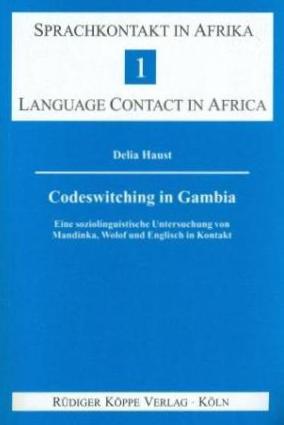
Codeswitching in Gambia
Eine soziolinguistische Untersuchung von Mandinka, Wolof und Englisch in Kontakt. With an English Summary
Author: Delia Haust. Series edited by: Hans-Jürgen Sasse †, Rainer Voßen.
Series: LCA Language Contact in Africa Volume 1
199516 pp. Roman, 372 pp.
20 tables, 70 diagrams, appendix: 55 tables
Text language(s): German
Format: 160 x 240 mm
780 g
Paperback
€ 69.80
Buy 'Codeswitching in Gambia' as a downloadable PDF document directly from our online shop »
Order 'Codeswitching in Gambia' as print edition »
The first part of the present study covers theoretical aspects of codeswitching, using two discourse-pragmatic and two grammatical models. On the basis of these models the author develops a framework for her empirical study of the double overlapping diglossia in Gambia, where two African lingua francas serve as Low varieties in contrast to the official language English, and as High varieties in contrast to the local languages.
Haust includes brief sketches of the main languages involved, Mandinka and Wolof, reproduces the questionnaires and data of the informants, followed by diagrams and cross-tabulations showing the cases of codeswitching. The final chapters give a structural categorization of codeswitching and its sociopragmatic criteria.
Under these links you will find publications by the author, further descriptions of the Mandinka language and culture and studies of sociolinguistics:
Accompanying material:
- From Rendille to Samburu
(ISBN 978-3-89645-911-4 ) - L’expression du temps en wolof
(ISBN 978-3-89645-557-4 ) - La qualification dans les langues africaines / Qualification in African Languages
(ISBN 978-3-89645-253-5 ) - Language Contact in Guinea
(ISBN 978-3-89645-906-0 ) - Les Bisa du Burkina Faso
(ISBN 978-3-89645-012-8 ) - The Role of Wolof in Multilingual Conversations in the Casamance
(ISBN 978-3-89645-087-6 ) - Tigrinya–English/Amharic Codeswitching
(ISBN 978-3-89645-997-8 )
Cross-reference:
- Historical Language Contact in Africa
(ISBN 978-3-89645-091-3 ) - Linguistic Landshapes
(ISBN 978-3-89645-085-2 ) - Mandinka Spoken Art
(ISBN 978-3-927620-63-6 ) - Sprache und Musik in Mandinka-Erzählungen
(ISBN 978-3-89645-265-8 ) - Tsotsitaal in South Africa
(ISBN 978-3-89645-086-9 ) - Vies quotidiennes à Dakar (Sénégal) / Everyday Life in Dakar (Senegal) / Nettaliy dundin ci Ndakaaru, bis bu nekk
(ISBN 978-3-89645-285-6 )
Reviews
This Ph.D. thesis from Hamburg deserves attention not only because it is the first volume of a new series on language contact in Africa. It is also an interesting case study of the sociolinguistic situation in a country about which very little information has as yet been published and of the unusual phenomenon of double overlapping diglossia there, where two African lingua francas serve as L(ow) varieties in contrast to the official language English, and as H(igh) varieties in contrast to the local languages. Such complex situations may become more common in Africa in those areas where African lingua francas are developped. [...]
To sum up, a striking feature of the book is that it looks at CS from as many different angles as possible and still manages to build a mosaic where each detail falls into place to complete the picture [...]
Josef Schmied in International Journal of Applied Linguistics, 6/1, 1996, 155-159
| « back | Print version | [top] |
 Books
Books Audio
Audio Biographies
Biographies Series
Series Festschrifts
Festschrifts Journals
Journals